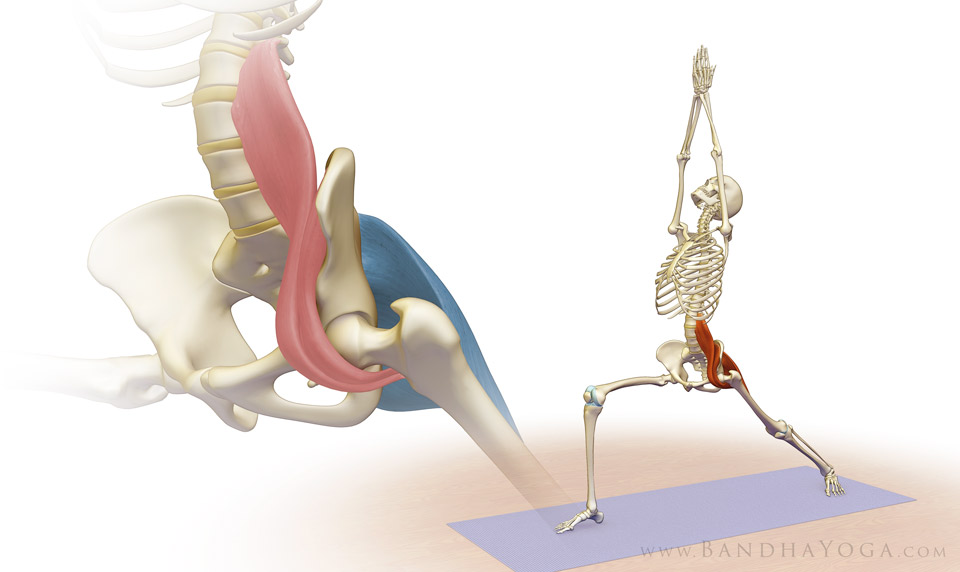The Psoas Awakening Series synergistically combines the standing poses to awaken the psoas muscle. We accomplish this by first contracting the psoas in poses that face forward, then in poses that face the side. We complete the series with twisting postures.
Click here to review the details of this important muscle.
Remembering that this muscle is usually “hidden” in the unconscious part of the brain, we must first isolate the psoas in each pose, bringing it back to consciousness.
I use the technique of isometric contraction to isolate and awaken a dormant muscle. This technique requires an understanding of the action of the various muscles. For example, the psoas acts to flex the hip, i.e., contracting the psoas either bends the trunk forward or draws the knee up. If you are contracting your psoas on one side, it laterally flexes your trunk. It is also synergizes external rotation of the hip.
Isolate your psoas (and its synergist muscles) by attempting to flex the trunk or by trying to lift the leg. Accentuate this by resisting the action. Check out figure 1 below for how to do this with Trikonasana. You can then transport the technique to other poses.

Place your elbow on your thigh as shown. Then, attempt to press the elbow down against your thigh by flexing your trunk to the side (arrow 1). Relax for a moment and then attempt to lift your leg straight up against your elbow. Finally, press down with your trunk and attempt to lift your leg against your elbow simultaneously. Neither your trunk nor your thigh will move in either of these actions, but you will feel your psoas muscle engage in your pelvis.
Remember, it is not necessary to use maximum contraction. Work with around twenty percent of your max force. Use gradual engagement with these cues and ease in to the contraction. Similarly, ease out of the movement and pose.
This general sequence will be repeated for each pose throughout the series.
Figure 2: Co-contracting your glutes and psoas.

Balance and stabilize your pelvis by contracting your back leg gluteus maximus. Note that the psoas of your forward leg creates a force that tilts your pelvis forward while the glute of the back leg tilts the pelvis back. These two forces act across the strong ligaments of the pelvis to stabilize the entire unit. This is known as "ligamentotaxis". Feel how this action stabilizes your pose from your core.
Figure 3: Balance Contraction with Stretch

Remember that Hatha Yoga combines opposites—the sun and moon or yin and yang. With this in mind, balance contracting the psoas by stretching it.
Figure 3 illustrates the genius of Hatha Yoga standing poses. While you contract your psoas in the forward leg, you relax and stretch your psoas of the back leg. Thus, each side of the pose balances the other.
Finally, experience “Body Clairvoyance.” This refers to the awakened body’s ability to anticipate an action and use the most efficient muscles to accomplish it—without thinking about it. The Psoas Awakening Series sequentially activates different parts of the psoas—incrementally and synergistically. When the brain sees a conscious combination of actions like this, it will then automatically use the psoas in unrelated actions. This is analogous to running up a flight of stairs. The first steps are taken consciously, but once we get going we ascend unconsciously (and rhythmically). The act of typing on a keyboard is another example of this.
Put another way, once we’ve awakened the dormant psoas muscle, we begin to use it unconsciously in new tasks.
I demonstrate this phenomenon in my workshops by finishing the Psoas Awakening Series with an inversion such as Full Arm Balance. Students regularly report a sensation of rock solid stability in their pose. This comes from the unconscious brain automatically activating the newly awakened psoas and stabilizing the pelvis. Experience this for yourself by practicing an unrelated asana at the end of the series.
Practice tips:
1) Always build contraction of a muscle gently and slowly. This aids to minimize the risk of injury and soreness.
2) Only contract the psoas to approximately 20% of its maximum force.
3) Awakening a muscle is accomplished by contracting it. Balance engaging a muscle by stretching it at the end of your practice.
4) Allow ample time for recovery between practice sessions.
5) Always practice under the guidance of an experienced teacher.
6) Always, in your particular case, consult your health care provider before doing yoga or any exercise program.
If you are new to integrating anatomy into your practice, remember that it is not necessary to memorize this technique on your first pass. Begin by enjoying the beautiful images of the body in yoga. This alone will awaken your brain's awareness of the anatomy during your practice. Return at a later date for a closer look, and then gently go through the motions illustrated above as you do the pose. Then leave it. Your unconscious mind will create new circuitry while you rest. Enjoy this process, and when you return to the mat, you will be surprised at how easily you access this technique.
You can apply this same technique of muscle awakening to your accessory muscles of breathing and dramatically expand your chest during your poses and pranayama. Click here for more information.
Namasté,
Ray and Chris
